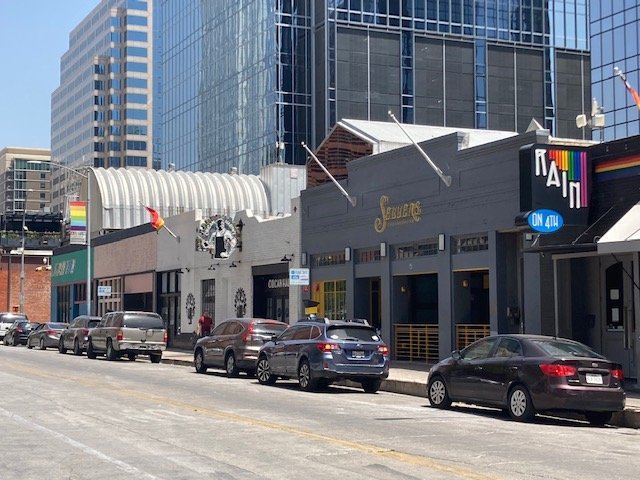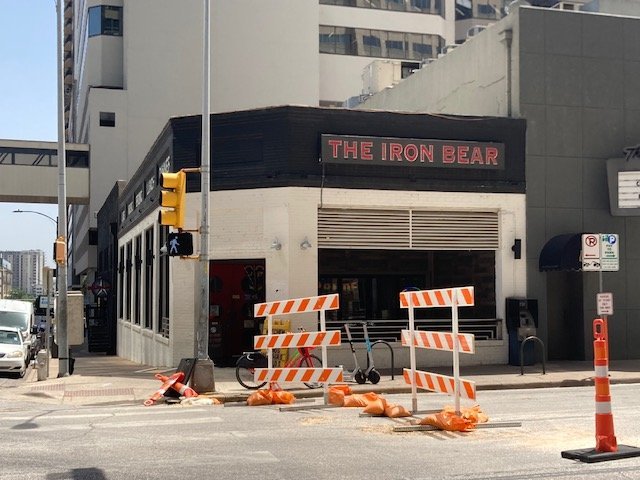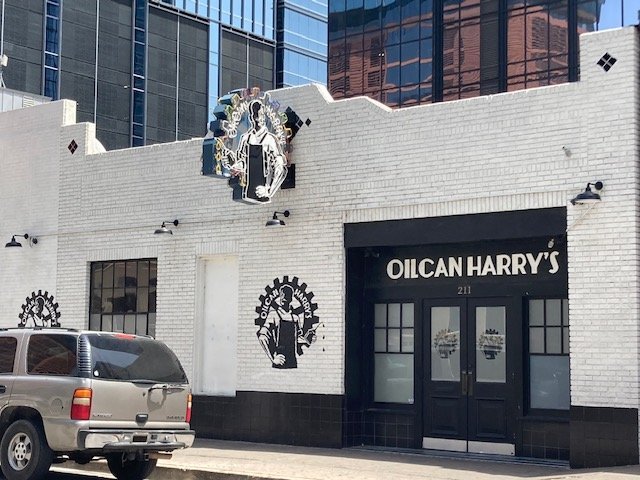Issues in Preservation: LGBTQIA Spaces and a Fight for Austin's Soul
BY MARY KAHLE, PRESERVATION AUSTIN SPRING POLICY INTERN
Photo: Bret Brookshire
“We have to do what’s in the best interest of these properties.” So said members of Austin’s Historic Landmark Commission (HLC) on June 1, when they made the difficult decision to accept a compromise involving the displacement of several bars beloved to the LGBTQIA community.
It was an about-turn after the commission voted in May to initiate historic zoning based on the developer’s initial proposal. That proposal entailed the total demolition of the properties, along with the retention of some of the historic facades and a promise to reinstate Oilcan Harry’s, founded in 1990, at a reduced rent. As discussed in Community Impact Newspaper, “new plans put before the commission … include only partial demolition of several West Fourth buildings and the total demolition of 310-318 Colorado as well as a redesigned floor plan including a new gay-owned club.” The HLC voted to indefinitely postpone a decision on the case, with the requirement that the provisions for partial demolition and façade retention are met, along with an agreement to support the sustainability of the affected establishments during construction.
Photo: Mary Kahle
The case comes on the heels of a March redevelopment request involving the Iron Bear (301 W. 6th St.), another LGBTQIA bar that aroused similarly impassioned community feedback. In that case, the Iron Bear failed to be recommended for historic zoning to the City’s Planning Commission because the required supermajority wasn’t present to do so at the May meeting, despite the HLC having voted in March to initiate historic zoning.
These two cases pose important issues in historic preservation. First and foremost, they demonstrate how important physical spaces are to communities, particularly marginalized communities, in fostering a sense of safety. As a petition in support of preserving the Fourth and Colorado area states, “The vibrancy, energy, safety, and comfort of our community needs to be protected at all costs to allow those in the LGBTQIA community to find themselves, find their people, and meet others they know will support them in an environment that has zero tolerance for hate.” Speakers at the HLC meetings likened the displacement of the bars to the erasure of their community, saying, “places such as these truly save lives.” They cited examples such as the high rate of LGBTQIA youth who have considered suicide and instances when family ostracized them and they found welcome in these bars. Others noted the intersection of LGBTQIA identity and race, where the stakes for personal safety are even higher for people of color.
The Manhattan Club at 905 Congress Ave (PICH-01461, Austin History Center, Austin Public Library)
Austin’s earliest gay bar, the Manhattan Club, opened in 1957 and offered opportunities for friendship and networking in addition to providing a safe haven. In describing these cases, City staff wrote that “gay bars are broadly acknowledged as a place for grassroots organization and safe space for the LGBTQIA community.” Further, Oilcan Harry’s possesses unique community value, forming “the nucleus of Austin’s LGBTQIA entertainment district [and] contributing to the image and cultural identity of a particular group.” The oldest continuously operating LGBTQIA bar in Austin, Oilcan Harry’s hosted fundraisers for Project Transitions, a nonprofit that provides services to those living with HIV and AIDS, and it was named one of the world’s best gay bars by Out Magazine. This history is important because community value is one of five criteria for historic designation that the HLC evaluates when making its recommendations. (To obtain Historic Landmark designation in Austin, a building, cemetery, or other site must be fifty years old or older, retain historic integrity, and meet two of five criteria for significance.)
The bars also reflect the LGBTQIA community’s contributions to Austin’s cultural scene, and their patrons appreciate the aesthetic appeal of the industrial architecture that evokes Austin’s history and their role within it. Urging the HLC to deem the entire area around Oilcan Harry’s a historic district (which the 2011 Downtown Austin Plan recommended), speakers pointed out that Austin’s rainbow crosswalks lie near the portion of Fourth Street memorializing progressive icon Bettie Naylor . Demolishing the surrounding buildings would negate the cultural and political history that these features represent and remove decades of history “in one fell swoop.” Others noted the irony of the situation for a city that “loves to pride itself as a blue oasis in sea of red” and lamented the loss of its famous “Keep Austin Weird” identity.
Photo: Bret Brookshire
Another important factor is that of a property owner’s rights versus the desires of the community. As alluded to above, a 2019 rule change by the Texas Legislature requires a supermajority (9 votes) of the HLC or the City’s Planning Commission, and a supermajority of City Council, to zone a property historic over the objections of the owner. In effect, this means that virtually every future historic landmark or district will be subject to this stringent voting threshold, necessitating the sorts of compromises revealed in the Fourth and Colorado case. Further, some argue that no one person or entity has the right to designate a property historic over the owner’s wishes regardless of City processes or regulations.
In the case of the Iron Bear, the developer and the bar’s owner opposed historic designation. In the Fourth and Colorado case, the developer made efforts to work with the LGBTQIA community by retooling the proposal to protect the facades, scale back the demolition, and include LGBTQIA businesses in the proposed business fabric. Knowing the high bar required for historic designation, the HLC opted for the compromise to protect what they could. Whether this will be sufficient to retain the character of the block is an open question with ardent adherents on all sides. Late City of Austin Historic Preservation Officer Steve Sadowsky and current City staff supported the proposal, the developer of the tower sought a “compassionate sustainable approach,” members of the HLC decried the lack of tools available to them to work with developers, and everyone who loves these spaces was left saddened.
Yet another factor is the history of the structures themselves, their architecture or historical associations, and the extent to which they have “integrity,” the ability of a property to convey its historical significance. The National Register of Historic Places applies seven factors (location, setting, design, materials, workmanship, feeling, and association) to evaluate a property’s integrity. The structures in both cases have varying levels of integrity, with 211 W. 4th (Oilcan Harry’s) having moderate to high integrity.
City staff recommended historic zoning for the building housing the Iron Bear based on its architecture and historical associations, writing, “The building is a good example of early twentieth century industrial architecture and is named as a high-priority warehouse in a 2009 study. … It is associated with the earliest period of modern refrigeration in Austin, and, though some … modifications have taken place over the years, it appears to be the only intact, purpose-built structure remaining of this type and era within the downtown warehouse district; thus, it represents a rare example of an architectural style in the city.” Further details on the case can be found in the HLC’s backup materials (May 4, 2022, A.4).
Its historical associations include its use for ice cream companies, a seed company aligned with the World War II Victory Garden effort, the electronics department of a business college, and other purposes. However, because the Iron Bear has only been housed in the structure since 2019, “the building’s documented association with Austin’s LGBTQIA community does not appear within the historic period,” which is subject to a fifty year age threshold. Further, the modifications to the building over the years compromise its integrity. A speaker advocating against historic zoning also noted that the structure isn’t in the warehouse district and thus by implication isn’t historically significant. The irony, of course, is the generally accepted acknowledgement that the warehouse district is significant, and yet the Fourth and Colorado case became the next victim on the chopping block. Regardless, the absence of a supermajority for a crucial vote doomed its possible historic designation, although the likelihood of such an outcome was slim to none.
Photo: Mary Kahle
The Fourth and Colorado case, which prominently featured Oilcan Harry’s, revealed similar issues. Involving several different buildings, it was divided into four cases by City staff for simplicity. Details on City staff’s recommendations and the structures’ architectural, historical, and community significance can be found in the HLC’s backup materials (June 1, 2022, A.4-A.7). Their historic uses included automotive operations, restaurants, a bread company, office space, beer distribution, a bus garage, a manufacturer of window shades, and nightclub use. The 1928 Patton-Eichenbaum building (213 W. 4th) is associated with Harold Eichenbaum, whose successful window display and decorations manufacturing business operated from the late 1940s through the early 1980s. Eichenbaum had a storied history as a theater designer for the Paramount and a parade float artist in addition to his history of assisting Jewish refugees escaping Nazi Germany.
Ultimately, City staff did not recommend historic designation for this constellation of circa 1920s-1930s warehouses, although they described the features of 211 W. 4th Street, home of Oilcan Harry’s, that made it a high priority for inclusion in a potential historic district per the 2009 survey. It is “a particularly intact example of a utilitarian warehouse with modest Mission Revival stylistic influences,” with decorative diagonal tiles and a multi-light steel window with a central awning sash. Like the Iron Bear, however, the property housing Oilcan Harry’s “does not appear to have individually significant associations within the historic period” or an even earlier period (dating to 1875) when the area was a red-light district. However, under Criteria Consideration G of the National Register of Historic Places, a property that isn’t fifty years old may demonstrate exceptional significance, making it eligible for historic designation. City staff noted that “Oilcan Harry’s … status as Austin’s oldest operational gay bar may meet the threshold to demonstrate exceptional significance.” (Examples of Consideration G include Dealey Plaza and the historic resources of NASA.)
Photo: Bret Brookshire
There are additional layers to the debate. Some housing advocates support the redevelopment of the sites to increase the housing supply, while others claim that building luxury housing will do nothing to address the affordability crisis. Still other preservation supporters note that the LGBTQIA community kept the affected area alive during COVID when so many businesses suffered economic setbacks. A common refrain is one that’s heard when demolitions across town are proposed for historic properties: What is the tipping point when the area or neighborhood is no longer historic due to the number of demolitions, which (ironically) weakens the argument for further preservation? In the case of the warehouse district, the tipping point is fast approaching. In supporting the compromise, the HLC recognized that historic zoning for the buildings would not necessarily save the businesses, and that not taking the deal could leave the area susceptible to a more damaging redevelopment proposal.
Given Austin’s rapid growth based heavily on the appeal of these valuable historic places, HLC Chair Terri Myers wondered, “Are we killing the goose that laid the golden egg?” Another great question to ask.
MARY KAHLE IS PRESERVATION AUSTIN’S SPRING 2022 POLICY INTERN. SHE IS A GRADUATE STUDENT IN PUBLIC HISTORY AT TEXAS STATE UNIVERSITY.







